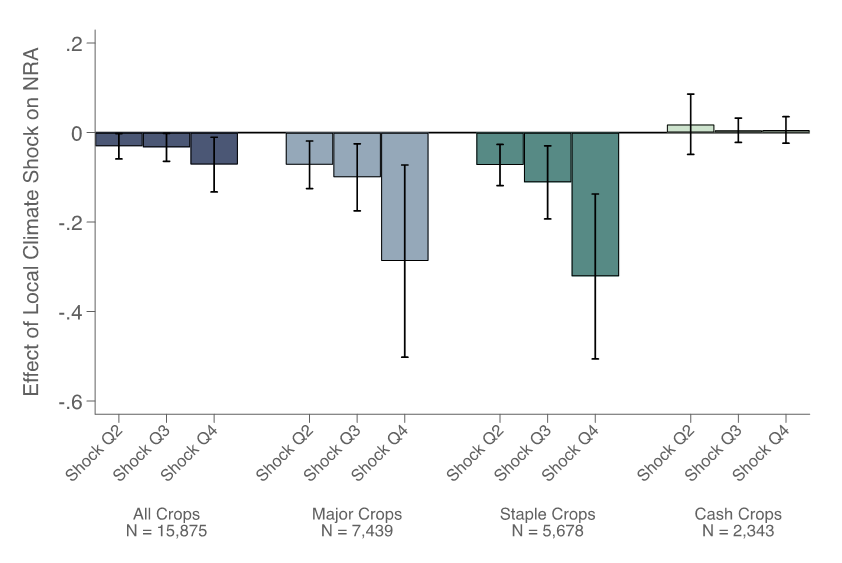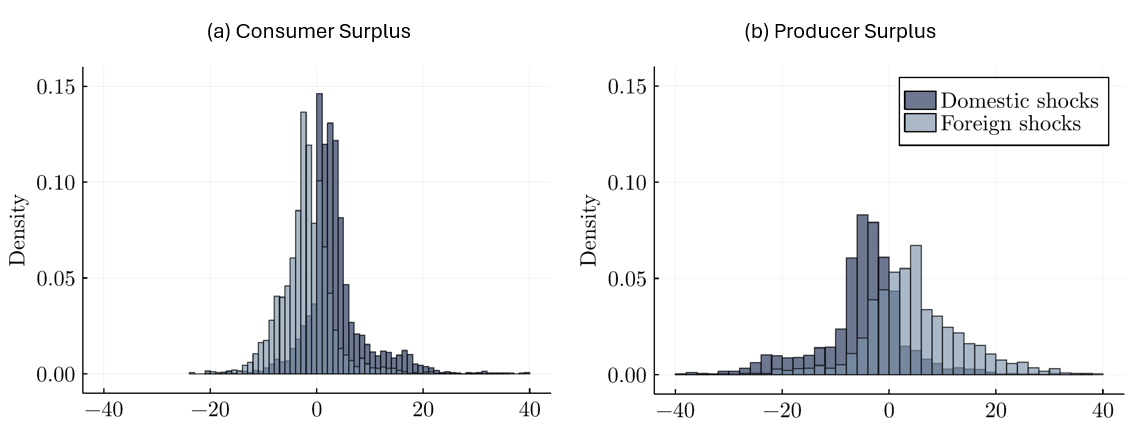
Governments often seek to protect domestic consumers following climate shocks to agricultural production, but these policies may exacerbate global losses.
In March 2022, a heat wave in India reduced expected wheat output by over 10 million tonnes*. On May 13, the Indian government banned wheat exports, citing concerns that high wheat prices threatened food security. The policy was met with immediate controversy. Farmers criticised the government for increasing the burden of the drought by cutting off their ability to sell at high international prices (Yasir and Kim 2022). International critics noted that, by pushing up global prices, India’s unilateral policy might exacerbate food security concerns elsewhere in the world (Lockett and Fildes 2022).
This story of government intervention in response to global warming is not unique to India. Just in 2023, similar stories of climate shocks, policy interventions, and controversy unfolded in Indonesia, Myanmar, Spain, Turkey, Kenya, Tanzania, and Morocco (Ghosal et al. 2023). In the coming decades, governments will face more such decisions as climate shocks become more frequent and severe. These policy responses will critically shape global capacity to adapt to a warming world.
In our research (Hsiao, Moscona, and Sastry 2024), we investigate the interaction between climate change and food policy around the world. Does food policy systematically react to environmental shocks, as the anecdotes above suggest? If so, how and why? And what do these policy responses imply for the consequences of climate change?
Data on climate change and food policy
To answer these questions, we compile a global data set of extreme heat exposure and agricultural market interventions by crop and country since 1980. We measure extreme heat exposure with global data on daily temperature realisations, combined with expert-elicited estimates of the maximum growing temperatures for specific crops. Our measure varies across time and space, given changes in the distribution of temperature shocks, and it varies across crops, given differential sensitivities of plant species to temperature shocks. This measurement strategy builds on a large body of quantitative evidence documenting that extreme heat exposure is the principal channel through which temperature affects crop output (e.g. Schlenker and Roberts 2009).
Our primary measure of crop-specific agricultural policy comes from the World Bank’s “Distortions to Agricultural Incentives” project (Anderson 2009). This database builds on extensive research on policy interventions to construct the nominal rate of assistance (NRA), which measures distortions in domestic prices relative to international prices for 80 agricultural products and 81 countries, covering 85% of global agricultural production (Anderson et al. 2013). The NRA measure captures a range of policy instruments, including border taxes, quantity restrictions, and domestic agricultural policies.
Figure 1 illustrates the data that we use in our main analysis. Figure 1a displays the change in extreme heat exposure from the 1980s to the 2010s across countries for maize. Countries are colour-coded by quartile, where darker shades of red correspond to larger increases in extreme heat exposure. Figure 1b displays the change in NRA for maize across countries. Countries are again colour-coded by quartile, where higher values correspond to larger shifts toward producer assistance and lower values correspond to larger shifts toward consumer assistance. Figure 1c shows the variation that we exploit in our main analysis, plotting extreme heat exposure and NRA over time for India. While extreme heat exposure has increased over the sample period, there are large fluctuations from year to year. NRA also fluctuates over time, even shifting between positive (pro-producer) and negative (pro-consumer) values.
Figure 1: Extreme heat exposure and agricultural policy

Notes: Figure 1(a) displays the change in the extreme heat exposure of maize from the 1980s to the 2010s. Countries are color-coded by quartile, where higher values correspond to larger increases in maize extreme heat exposure. Figure 1(b) displays the change in the nominal rate of assistance (NRA) for maize from the 1980s to the 2010s for all countries with data. Countries are color-coded by quartile, where higher values correspond to larger relative increases (i.e., more pro-producer) shifts in NRA. Figure 1(c) plots the changes in NRA (left y-axis) and extreme heat exposure (right y-axis) in India from 1980-2020.
How does food policy respond to extreme heat shocks?
We find that domestic extreme heat shocks induce consumer assistance through policy interventions that reduce food prices. Figure 2 reports our baseline findings. Each set of bars displays the effect on NRA of being in each quartile of extreme heat exposure, relative to the bottom quartile, for a different set of crops. These estimates are from two-way fixed effects regressions that absorb country-level and crop-level trends in extreme heat or policy, exploiting only country by crop by year variation. We find larger effects when focusing on economically important crops and staple crops. A change from the first to fourth quartile of extreme heat exposure results in a more than 30 percentage point reduction in NRA. That is, a country with no initial policy distortion would introduce a 30% consumer subsidy.
Figure 2: The relationship between extreme heat exposure and agricultural assistance

Notes: This figure displays the relationship between quartiles of extreme heat exposure and NRA. The unit of observation is a country-crop-year, and we include all possible two-way fixed effects. Each set of three bars corresponds to estimates from a single regression. The sample of crops included in each regression is noted below each set of bars. We report 90% confidence intervals.
We corroborate this finding in other datasets. We find that extreme heat shocks lead to lower border tariffs, as measured in the UN Trade Analysis Information Systems (TRAINS) database, and a higher likelihood of export restrictions, as measured in the Global Trade Alert (GTA) database. Our findings suggest that the Indian wheat anecdote generalises: governments react to climate shocks with policy interventions designed to shield local consumers. At the same time, these interventions exacerbate the costs of climate shocks for local producers and for consumers in other parts of the world.
We also study how policy responds to food shortages originating abroad. We construct measures of global agricultural distress, as well as more targeted measures of extreme heat shocks to a given country’s import suppliers. In both cases, we find that foreign extreme heat shocks induce producer assistance that increases the price of food. That is, threats to food security originating overseas have the opposite effect on policy as those originating domestically. These results are consistent with a model of government decision making based on domestic distributional considerations. They are inconsistent with a model in which governments’ primary goal is to solely reduce price fluctuations faced by consumers, regardless of the origin of these fluctuations. This finding also runs counter to popular narratives of food policy “contagion” (Ghosal et al. 2023) and accounts of food policy restrictions spreading from one country to another (de Guzman 2022).
In further results, we show that policy responds not only to yearly fluctuations in extreme heat but also to decadal changes in extreme heat. Governments use policy to mediate the consequences of climate shocks on longer time horizons. Moreover, we find that policy responses are significantly larger during election years, when politicians may be especially willing to sacrifice fiscal responsibility to win the support of constituents (e.g. Alesina and Roubini 1992).
How do these policy responses shape the aggregate welfare effects of climate shocks?
To address this question, we combine our empirical estimates with a quantitative model of trade, production, and policymaking. We first consider the historical extreme heat shocks in our study sample. In markets hit by an extreme heat shock, responsive policy fully shields domestic consumers from surplus losses. Domestic prices increase by 1.6% when policy is fixed, but policy responses reduce the price increase to zero. At the same time, policy interventions amplify producer surplus losses, which increase from 9.8% to nearly 15%, and foreign consumers suffer similarly. Policy responses to climate shocks reshape the global distribution of economic damages, both within and across markets.
Figure 3 shows the large effects of responsive policy on consumer and producer surplus across markets, separated by whether they experience domestic or foreign shocks. The darker histograms display the distribution of effects for markets hit by domestic shocks. Responsive policy moves to keep domestic prices low, assisting consumers but hurting producers. The lighter histograms display the distribution of effects for markets hit by foreign shocks. Here, responsive policy moves to keep domestic prices high, assisting producers but hurting consumers. In both cases, policy affects surplus losses by as much as 20 percentage points.
Figure 3: The impacts of responsive policy on consumers and producers across markets

Notes: We compute surplus effects in percentage terms of historical extreme heat shocks relative to a baseline without shocks. Each observation is a country-crop-year “market" subject to domestic shocks or foreign shocks. Dark blue shading indicates observations with a domestic shock, while light blue indicates those with a foreign shock. Positive values denote surplus gains (or smaller losses) under responsive policy relative to unresponsive policy.
Finally, we speculate on how government policy might shape the consequences of projected end-of-century climate change. We find a similar pattern of distributional impacts across consumers and producers. Policy shields consumers in markets most affected by climate shocks, while exacerbating losses for producers in those markets and consumers in other parts of the world. Moreover, responsive policy has a large, negative effect on overall efficiency, exacerbating global welfare losses from extreme heat shocks by 14%. Projected shocks are large and widespread, and they induce policy responses that intensify baseline distortions in many markets. These policy distortions worsen aggregate climate damages.
Takeaways for policy
Global leaders in policy making and diplomacy argue that “food security rests on trade” (Gurria and da Silva 2019). Yet our research suggests that governments are willing to alter food policy and restrict trade in response to climate shocks to productivity. While there is a political logic to these interventions, and consumers in the most affected places may stand to benefit, they come with potential costs to producers and consumers around the world. Policy changes thus redistribute the economic losses from climate extremes and, according to our estimates, may exacerbate the overall economic losses from global warming. That is, climate damages depend crucially on government action. Better understanding the political realities of this action will be an important avenue for future research.
*Editor's note: This figure has been amended from "100 million tonnes" which appeared in the original version of the article.
References
Alesina, A and N Roubini (1992), "Political cycles in OECD economies", Review of Economic Studies, 59(4): 663–688.
Anderson, K, editor (2009), Distortions to Agricultural Incentives: A Global Perspective, Palgrave Macmillan.
Anderson, K, G Rausser, and J Swinnen (2013), "Political economy of public policies: insights from distortions to agricultural and food markets", Journal of Economic Literature, 51(2): 423–477.
Ghosal, A, E Musambi, and J Calupitan (2023), "Food prices are rising as countries limit exports. Blame climate change, El Nino and Russia’s war", AP News.
Gurria, A and J G da Silva (2019), "Food security rests on trade", OECD News.
Guzman, C de (2022), "Climate crisis is driving food nationalism and changing global trade", Time Magazine.
Hsiao, A, J Moscona, and K Sastry (2024), "Food Policy in a Warming World".
Lockett, H and N Fildes (2022), "Wheat prices rise almost 6% as India export ban shakes markets", Financial Times.
Schlenker, W and M Roberts (2009), "Nonlinear temperature effects indicate severe damages to us crop yields under climate change", Proceedings of the National Academy of Sciences, 106(37): 15594–15598.
Yasir, S and V Kim (2022), "India bans most wheat exports, adding to concerns of global food insecurity", New York Times.



